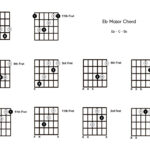Double neck guitars, especially those combining a bass and a guitar, hold an undeniable allure for musicians. The idea of seamlessly switching between the low-end rumble of a bass and the melodic range of a guitar within a single instrument is captivating. However, the reality of crafting a functional and player-friendly double neck instrument is fraught with challenges. Experiences, such as those shared in online guitar building communities, highlight critical considerations that anyone contemplating a Bass And Guitar Double Neck project must address.
One seasoned luthier recounted an experience with a factory-made double neck guitar that serves as a cautionary tale. While the specific instrument was a 6-string and 12-string guitar combination, the ergonomic and construction principles are directly applicable to bass and guitar double necks. The guitar in question suffered from a multitude of design flaws that rendered it unwieldy and structurally unsound.
The most immediate issue was the sheer weight and imbalance. Even with a body presumably made of basswood, the guitar was described as “incredibly heavy.” This weight was compounded by severe neck-heaviness. Imagine the combined weight of two necks, tuners, and fretboards extending outwards – the physics quickly become problematic. The result was an instrument that was impossible to play comfortably while standing with a strap and equally awkward when seated. The ergonomics were further compromised by the close proximity of the two necks. Switching between the bass and guitar necks felt unnatural, and the unused neck constantly interfered with the playing hand. This highlights a crucial point: simply combining two instruments into one body doesn’t automatically create a playable hybrid. Careful consideration of instrument balance and neck placement is paramount in a bass and guitar double neck design.
Beyond ergonomics, the construction of this double neck guitar was fundamentally flawed. It utilized set necks with short tenons that didn’t adequately extend into the body. Adding to the structural weakness, the factory had neglected to remove paint from the neck joint surfaces before gluing. This is a critical error in guitar construction, as glue adheres poorly to painted surfaces, leading to inevitable joint failure. Predictably, the neck joint failed. In a misguided attempt at repair, the owner resorted to pouring epoxy into the joint cavity – a temporary and ultimately ineffective solution.
While the neck was eventually reglued correctly, the underlying design flaws remained. This experience underscores the importance of robust neck joint design in double neck instruments. The combined string tension and weight of two necks place immense stress on these joints, demanding meticulous construction and ample gluing surface.
For anyone contemplating a bass and guitar double neck project, the advice is clear: thorough planning is essential. Carefully consider the geometry of the instrument, including scale lengths for both bass and guitar necks, the desired body joint positions, and access to upper frets. Critically assess the weight of the necks, tuners, and hardware and how these factors will affect the overall balance of the instrument. Strategically plan the strap button placement to optimize playing comfort. Most importantly, pay meticulous attention to the neck-to-body joints. Ensure they are robust, well-supported, and designed to withstand the stresses inherent in a double neck instrument. Remember, while one neck is being played, the other is essentially “waving around,” adding to the dynamic forces acting on the instrument. Success in building a playable and reliable bass and guitar double neck hinges on addressing these potential pitfalls from the outset.


